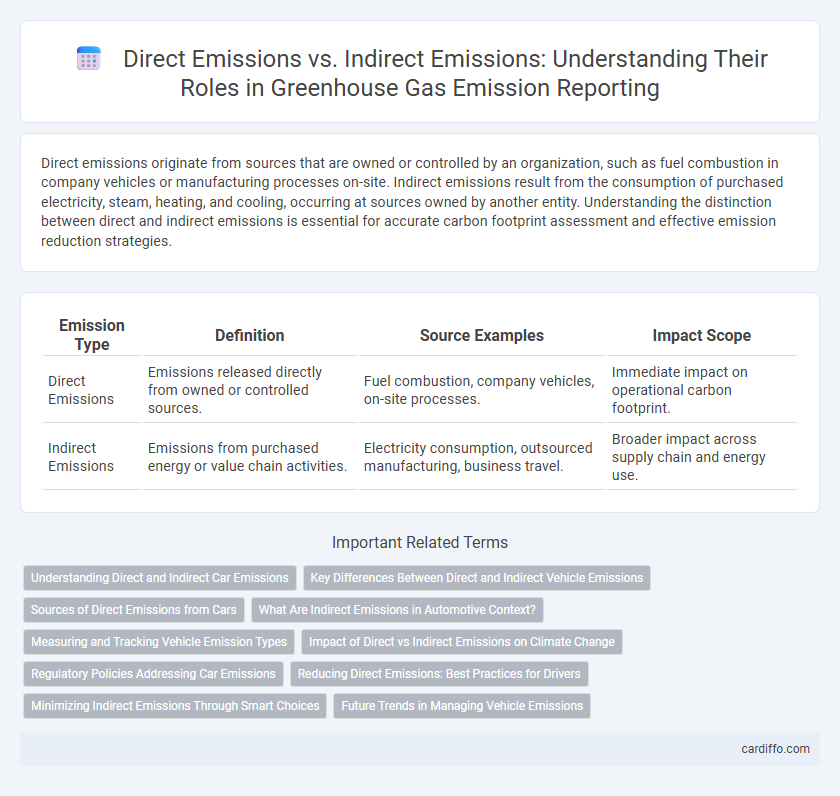Direct emissions originate from sources that are owned or controlled by an organization, such as fuel combustion in company vehicles or manufacturing processes on-site. Indirect emissions result from the consumption of purchased electricity, steam, heating, and cooling, occurring at sources owned by another entity. Understanding the distinction between direct and indirect emissions is essential for accurate carbon footprint assessment and effective emission reduction strategies.
Table of Comparison
| Emission Type | Definition | Source Examples | Impact Scope |
|---|---|---|---|
| Direct Emissions | Emissions released directly from owned or controlled sources. | Fuel combustion, company vehicles, on-site processes. | Immediate impact on operational carbon footprint. |
| Indirect Emissions | Emissions from purchased energy or value chain activities. | Electricity consumption, outsourced manufacturing, business travel. | Broader impact across supply chain and energy use. |
Understanding Direct and Indirect Car Emissions
Direct car emissions originate from the combustion of fuel within the vehicle's engine, releasing pollutants such as carbon monoxide, nitrogen oxides, and particulate matter directly into the atmosphere. Indirect emissions stem from the production and distribution of the vehicle's fuel or electricity, including emissions from oil extraction, refining, and electricity generation. Understanding the distinction between direct and indirect car emissions is crucial for accurately assessing the total environmental impact and developing effective strategies for reducing automotive carbon footprints.
Key Differences Between Direct and Indirect Vehicle Emissions
Direct vehicle emissions originate from the combustion of fuel within the engine, releasing pollutants such as carbon monoxide, nitrogen oxides, and particulate matter directly into the atmosphere. Indirect vehicle emissions result from the production and distribution of fuel, including extraction, refining, and transportation processes that contribute to greenhouse gas emissions off-site. Understanding the distinction between tailpipe emissions and upstream emissions is essential for comprehensive vehicle emission assessments and effective regulatory strategies.
Sources of Direct Emissions from Cars
Direct emissions from cars primarily originate from the combustion of fossil fuels such as gasoline and diesel within the engine's cylinders. These emissions include carbon dioxide (CO2), nitrogen oxides (NOx), carbon monoxide (CO), and particulate matter (PM), released directly from the vehicle's tailpipe. Factors influencing direct emissions include engine efficiency, fuel type, vehicle condition, and driving habits.
What Are Indirect Emissions in Automotive Context?
Indirect emissions in the automotive context refer to greenhouse gases produced from the generation of electricity, fuel production, and supply chain activities that support vehicle operation but occur outside the vehicle itself. These emissions include those generated during the extraction, refining, and transportation of fuels, as well as electricity used to charge electric vehicles. Understanding indirect emissions is crucial for comprehensive carbon footprint analysis and developing effective strategies for reducing overall automotive sector emissions.
Measuring and Tracking Vehicle Emission Types
Direct emissions from vehicles originate from the combustion of fuel within the engine, primarily releasing carbon dioxide (CO2), nitrogen oxides (NOx), and particulate matter. Indirect emissions refer to the environmental impact linked to the production and distribution of fuel, including emissions from electricity generation for electric vehicles. Accurate measurement and tracking of vehicle emission types combine onboard diagnostics, remote sensing technologies, and lifecycle analysis to optimize emission reporting and reduce overall environmental impact.
Impact of Direct vs Indirect Emissions on Climate Change
Direct emissions originate from sources owned or controlled by an entity, such as combustion of fossil fuels in vehicles or industrial processes, releasing greenhouse gases directly into the atmosphere. Indirect emissions result from the generation of purchased electricity, heating, or cooling consumed by the entity, contributing to climate change through upstream energy production emissions. The impact on climate change depends on the scale and source of emissions, with direct emissions often being the main contributor at the point of origin, while indirect emissions represent a significant portion of an organization's overall carbon footprint through scope 2 emissions.
Regulatory Policies Addressing Car Emissions
Regulatory policies targeting car emissions differentiate between direct emissions, produced by vehicles' tailpipes, and indirect emissions, linked to electricity generation for electric vehicles. Strict standards such as the Euro 6 and Tier 3 regulations limit pollutants like NOx and particulate matter from internal combustion engines, reducing direct emissions. Meanwhile, policies promoting renewable energy integration indirectly lower emissions associated with electric vehicle charging, supporting a holistic approach to reducing the automotive sector's carbon footprint.
Reducing Direct Emissions: Best Practices for Drivers
Reducing direct emissions involves adopting best practices such as maintaining regular vehicle servicing to ensure optimal engine performance and tire pressure, which improves fuel efficiency and lowers carbon output. Drivers can also minimize idling time and adopt smooth acceleration and deceleration techniques to reduce fuel consumption and harmful pollutants. Using fuel-efficient routes and carpooling further decreases direct emissions by lowering individual vehicle use and overall fuel demand.
Minimizing Indirect Emissions Through Smart Choices
Minimizing indirect emissions involves selecting renewable energy sources, optimizing supply chains, and promoting energy-efficient technologies across product lifecycles. Implementing sustainable procurement policies and encouraging remote work can significantly reduce emissions linked to purchased goods and employee commuting. Continuous monitoring and reporting tools help organizations identify high-impact areas and track progress toward lowering their carbon footprint effectively.
Future Trends in Managing Vehicle Emissions
Future trends in managing vehicle emissions emphasize the reduction of direct emissions from tailpipes through advanced electric and hydrogen fuel cell technologies. Indirect emissions are targeted by improving energy grid decarbonization and increasing the use of renewable energy sources for vehicle charging. Innovations in smart infrastructure and real-time emissions monitoring further optimize the balance between direct and indirect emission reductions.
Direct emissions vs Indirect emissions Infographic

 cardiffo.com
cardiffo.com